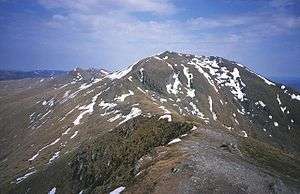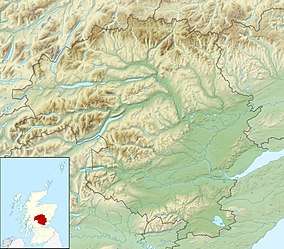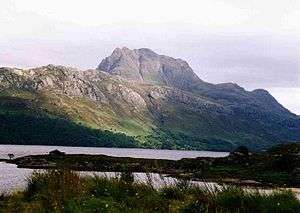Ben Lawers
Ben Lawers (Scottish Gaelic: Beinn Labhair)[2] is the highest mountain in the southern part of the Scottish Highlands. It lies to the north of Loch Tay, and is the highest point of a long ridge that includes seven Munros.[3] It is the highest peak in Perthshire,[4] and is the tenth highest Munro in Scotland. Ben Lawers was long thought to be over 4,000 feet (1,219.2 m) in height; accurate measurement in the 1870s showed it to be some 17 feet (5.2 m) short of this figure.[5]
| Ben Lawers | |
|---|---|
| Beinn Labhair | |
 Ben Lawers seen from Beinn Ghlas | |
| Highest point | |
| Elevation | 1,214 m (3,983 ft) [1] |
| Prominence | c. 915 m Ranked 11th in British Isles |
| Parent peak | Ben Nevis |
| Listing | Munro, Marilyn, Council top (Perth and Kinross), County top (Perthshire) |
| Coordinates | 56°32′44″N 4°13′15″W |
| Naming | |
| English translation | Hill of the loud stream or hoof or claw mountain |
| Language of name | Gaelic |
| Pronunciation | Scottish Gaelic: [peɲˈl̪ˠavɪɾʲ] |
| Geography | |
| Location | Perth and Kinross, Scotland |
| Parent range | Grampian Mountains |
| OS grid | NN636414 |
| Topo map | OS Landranger 51 |
Ben Lawers lies on the watershed between the rivers Tay and Lyon. Since the 1950s, water has been captured from the numerous burns on the south face of Ben Lawers and Meall nan Tarmachan as part of the Breadalbane Hydro-Electric Scheme. The water is diverted to the Lochan na Lairige, from where it is piped to drive hydro-electric turbines at Finlarig on the banks of Loch Tay.[4] The level of the Lochan na Lairige was raised by the construction of the 344 metre-long Lawers Dam, a buttress-type dam that is 42 m high. Due to the height of this reservoir the static head of water is 415 m, the highest available on any hydro-electric scheme in Scotland.[6]
Due to its high altitude and underlying geology Ben Lawers is home to an exceptionally rich selection of arctic-alpine plant species and habitats, and has been designated as a National Nature Reserve (NNR) since 1964.[4]
History
There is much evidence of former settlements and other human activity on the southern slopes of Ben Lawers above Loch Tay. The fertile limestone and schist soils on these southern slopes have been farmed since very early times and there are many Bronze Age remains. The discovery of many boulders with cup and ring marks led Derek Alexander, an archaeologist for the National Trust for Scotland, to note that the Ben Lawers was likely to have been "a very significant landscape in prehistory."[7]
Overgrown tracks climb up the mountain from the valley to the peat beds and sheilings on the hillside, and there are ruins of cottages each surrounded by a small group of trees. These, along with the remains of ridged pastures, are signs of early cultivation. This evidence of habitation, and the presence of huts associated with transhumance at high altitudes, demonstrate that local people are likely to have visited most if not all of the summits of the Ben Lawers range whilst grazing animals at height during the summer.[8] The mapmaker Timothy Pont visited the area 1590s, and writer Ian R. Mitchell considers that Pont's surveys show that he, or one of his associates, is likely to have climbed Ben Lawers, and should therefore be credited with earliest recorded ascent.[9] Otherwise, the earliest recorded ascent was by members of a party organised by military surveyor William Roy: although it is not certain that Roy himself climbed the peak, his writings show that measurements were taken from the summit of Ben Lawers on 17 September 1776.[8]
In 1878, a group of twenty men led by Malcolm Ferguson spent a day building a 6 metres (20 ft) high cairn nearly 15 metres (50 ft) in diameter in the hope of bringing the summit above the "magic" figure of 4,000 feet (1,219.2 m). The cairn, which was topped with a massive block of white quartz is no longer there; in any case the Ordnance Survey ignored it as an artificial structure that was not truly part of the hill.[5][10]
Ownership
Prior to the 14th century, the mountain stood on the lands of Clan MacMillan. Chalmers of Lawers obtained the land by force from the clan in the mid 14th century in the reign of David II. The land was confiscated from the Chalmers family in 1473 by James III and given to Sir Colin Campbell of Glenorchy after Thomas Chalmers was implicated in the murder of James I. The lands have mainly remained in the ownership of the Campbells of Glenorchy and Breadalbane right up to the present day, with some notable exceptions. Many of the farms were sold off in the late 1940s.
Most of the south side of the Ben Lawers range has since 1950 been owned by the National Trust for Scotland,[11] and was purchased through the generosity of Percy Unna, a mountaineer and one time president of the Scottish Mountaineering Club. The area of land under trust ownership was extended in 1996 by the purchase of the neighbouring Tarmachan range.[4] The trust built a visitor centre located at the western end of the range that had an exhibition that explained the geological formation of the mountain, but this was closed and demolished in 2010.[12] A new car park has been built on the opposite side of the road, from where a path leads to the summit of Ben Lawers by way of the intermediate peak of Beinn Ghlas. There is a nature trail on the lower section of this path, with information leaflets available in the car park.[13][14]
The northern side of the Ben Lawers range comprises three privately owned estates, at Roroyere, Roromore, and South Chesthill. All three cover land extending from Glen Lyon to the watershead of the ridge.[15][16][17] As with all land in Scotland, there is a right of responsible access to the hills regardless of whether the land is in public or private ownership, provided that access is exercised in accordance with the Scottish Outdoor Access Code.[18]
Nature and conservation
| Ben Lawers National Nature Reserve | |
|---|---|
IUCN category II (national park) | |
 | |
| Location | Perth and Kinross, Scotland |
| Coordinates | 56°32′44″N 4°13′15″W |
| Area | 44.4 km2 (17.1 sq mi)[19] |
| Designation | Scottish Natural Heritage (SNH) |
| Established | 1964[20] |
| Owner | National Trust for Scotland |
| Ben Lawers National Nature Reserve | |
Ben Lawers is regarded by botanists as one of the richest areas for alpine flora in the UK, due to the schist rocks of the mountain which are situated at the correct altitude for the plants. The rocks supply an adequate amount of calcium, magnesium, sodium, potassium and iron to the plants and breaks down to a clayish soil which retains moisture. Some of the plants found on Lawers include alpine forget-me-not, roseroot, net-leaved willow and most of the saxifrages.[21] The mountain is also of interest to zoologists. Some of the bird species include ravens, ring ouzels, red grouse, ptarmigan, golden eagle, peregrine falcon, dotterel, golden plover, and short-eared owls.[22][4] Other rare species include the viviparous lizard and the wildcat.[23]
The Ben Lawers range has been designated as a National Nature Reserve (NNR) since 1964.[19] In 2005 the boundary was altered so that all NTS land at Ben Lawers (including the neighbouring Tarmachan range) was included in the NNR, which the Trust now manages on behalf of Scottish Natural Heritage.[4] Ben Lawers is also designated as a Special Area of Conservation (SAC),[24] and a Site of Special Scientific Interest (SSSI).[21] The Ben Lawers National Nature Reserve is classified as a Category II protected area by the International Union for Conservation of Nature.[20]
The Ben Lawers range forms part of the Loch Rannoch and Glen Lyon National Scenic Area,[25] one of 40 such areas in Scotland, which are defined so as to identify areas of exceptional scenery and to ensure its protection from inappropriate development by restricting certain forms of development.[26]
Ascents
Ben Lawers is a popular mountain, resulting in path erosion and vegetation loss from the number of visiting hillwalkers. Since the 1980s NTS, in partnership with other groups, have undertaken work on the path network in an attempt to control the impact of the high visitor numbers.[4] The simplest route of ascent starts from the NTS carpark, following a path that reaches the summit via an intermediate peak, Beinn Ghlas. Alternative routes that avoid the erosion caused by the popularity of the main route usually start by following Lawers Burn, which meet the A827 at the village of Lawers. Heading north from this burn allows the walker to climb the peaks to the northeast of Ben Lawers on the way. The most direct route to the summit of Ben Lawers from Lawers is to continue along the Lawers Burn as far as the Lochan nan Cat ("lochan of the cat"), before heading straight to the summit by way of the east ridge.[3]
Gallery of images
- Ben Lawers seen from Loch Tay
 Ben Lawers in winter
Ben Lawers in winter- Lochan Nan Cat from the summit of Ben Lawers
 Ben Lawers and Meall Garbh
Ben Lawers and Meall Garbh Ben Lawers 3D map
Ben Lawers 3D map
References
- "Ben Lawers (Beinn Labhair)". Hill Bagging - the online version of the Database of British and Irish Hills (DoBIH). 2019. Retrieved 20 June 2019.
- "Database - Ben Lawers". Ainmean-Àite na h-Alba. Retrieved 7 February 2019.
- Donald Bennet & Rab Anderson, ed. (2016). The Munros: Scottish Mountaineering Club Hillwalkers' Guide. Scottish Mountaineering Trust. p. 32. ISBN 9780907521945.
- "Ben Lawers SSSI Site Management Statement". Scottish Natural Heritage. 25 March 2011. Retrieved 13 November 2018.
- D. Bennet (ed.) The Southern Highlands. Scottish Mountaineering Club District Guides - Scottish Mountaineering Trust. 2nd edition (August 1986). p. 161
- "Power From the Glens" (PDF). Scottish and Southern Energy. p. 20. Archived from the original (PDF) on 18 October 2007. Retrieved 8 March 2008.
- "Ancient stone artwork discovered". BBC. 17 August 2009. Archived from the original on 21 September 2009. Retrieved 20 September 2009.
- Ian R. Mitchell (2004). Scotland's Mountains Before the Mountaineers. Luath Press. pp. 39–40. ISBN 0946487391.
- Ian R. Mitchell (2004). Scotland's Mountains Before the Mountaineers. Luath Press. pp. 189–190. ISBN 0946487391.
- Historic Environment Scotland. "Ben Lawers (279696)". Canmore.
- NTS Guide (2018).
- Historic Environment Scotland. "Ben Lawers Visitor Centre (103356)". Canmore.
- "New visitor facilities planned for Ben Lawers". Walk Highlands. 8 June 2010. Retrieved 16 September 2004.
- "Ben Lawers and Beinn Ghlas". Walk Highlands. Retrieved 16 September 2004.
- "Property Page: Roroyere". Who Owns Scotland. 16 September 2004. Retrieved 14 November 2018.
- "Property Page: Roromore". Who Owns Scotland. 16 September 2004. Retrieved 14 November 2018.
- "Property Page: South Chesthill". Who Owns Scotland. 13 September 2004. Retrieved 14 November 2018.
- "Scottish Outdoor Access Code" (PDF). Scottish Natural Heritage. 2005. Retrieved 16 January 2018.
- "Site Details for Ben Lawers NNR". Scottish Natural Heritage. 5 April 2018. Retrieved 24 April 2018.
- "Ben Lawers in United Kingdom of Great Britain and Northern Ireland". Protected Planet. Retrieved 13 November 2018.
- "Ben Lawers Site of Special Scientific Interest Citation". Scottish Natural Heritage. Retrieved 13 November 2018.
- "Ben Lawers National Nature Reserve". National Trust for Scotland. Retrieved 13 November 2018.
- "Ben Lawers (NTS Guide)" Pages 24 & 25 (Gives biology details).
- "Site Details for Ben Lawers SAC". Scottish Natural Heritage. 5 April 2018. Retrieved 24 April 2018.
- "Map: Loch Rannoch and Glen Lyon National Scenic Area" (PDF). Scottish Natural Heritage. December 2010. Retrieved 19 March 2018.
- "National Scenic Areas". Scottish Natural Heritage. Retrieved 17 January 2018.
- Ben Lawers, National Trust for Scotland, ISBN 978-0-901625-54-0
External links
| Wikimedia Commons has media related to Ben Lawers. |
- Computer generated summit panoramas North South Index
- NTS Ben Lawers page
- Ben Lawers on Walk Highlands




